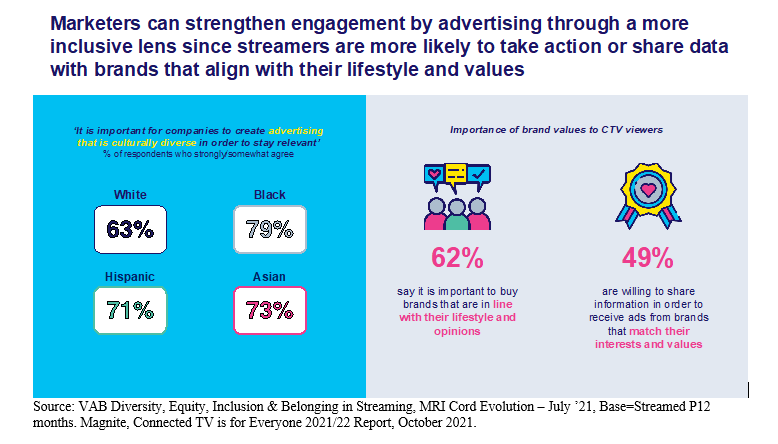2022: New Consumer Media Consumption Behaviors in the Post-Pandemic World and Their Impacts on Performance Media

As we enter the third year of COVID-19, even with a real hope that we are moving out of the pandemic phase, the entire concept of truly defining the trends that will stick or those that will (hopefully) fade into a distant memory is a conundrum wrapped in a mystery shrouded by enigma. But we're going to make a most valiant attempt. Whether it's the increased use of streaming services, the consumer churn that some of these streaming video services are beginning to experience as the initial subsidies from marketing partners end, social video, or the impact from the uptake of faster bandwidth, smart home assistants, and larger televisions, the media ecosystem has never been both as complex and yet full of opportunity.
Increased consumer time spent with technology and media has been sustained coming out of the pandemic. According to eMarketer, consumers increased time with technology and media by 58 minutes/day to 13 hours and 211 minutes/day hours since COVID-19 began, and forecasters expect this growth will be sustained.
As it has always been and will always continue to be, it all begins with the consumer. A deep understanding of their needs and what they value are table stakes in being able to effectively market and communicate with them versus to them. According to a recent Accenture survey, 50% of consumers say that the pandemic caused them to rethink their purpose and re-evaluate what's important to them in life. Forty-two percent say the pandemic made them realize they need to focus on others more than themselves. These consumers called the "Reimagined" are changing their buying habits accordingly. This presents an enormous opportunity for companies to reset their marketing strategies to encourage consumer engagement and sales.
As we move forward into 2022, it is important to focus on these key trends:
Technology Is Driving the Melding of Performance Media and Brand
Technology has played a critical role in enabling businesses to quickly adapt to service customer needs. It is also, as we saw in many examples during the 2022 Consumer Electronics Show, a key tool in addressing our labor and supply chain challenges.
Globally, over the next four years, eCommerce is expected to add more absolute dollars than physical retail. New technologies, such as AI-assisted shopping, 3D Digital Twins and Livestream Shopping will break down the barriers to higher eCommerce adoption and are enabling even the most expensive and complicated categories (e.g., automotive and insurance) to move online.
By bringing both the impact of sight, sound and motion along with a sense of immediacy and FOMO, Livestream Commerce is here and will continue to grow. Livestream shopping sales are expected to grow substantially over the next two years from $6B to $35B as consumers can purchase products directly from the video.
Live events can be extremely important for creating awareness and prompting trial by new customers but may not solidify loyalty. In terms of broad demographics, Generation X and Generation Z shop more online. But category by category, it can be complex. For example, in fashion, beauty and luxury goods, Millennials are the top-spending cohort with 31% in the U.S. market and Boomers come in at 25%. It's important to dig into the data at a granular level to understand your audience and what matters to them.
There are two primary paths for enabling livestream shopping; using a third-party platform like Amazon, Facebook, or Google's Shop loop or integrate the livestream platform with a retailer's e-commerce platform. While third-party platforms are easier to implement, the integration of a livestream shopping platform into an owned website or mobile app gives retailers control with data capture and retargeting. Players in this space include Bambuser and LiSA.
Brands will overcome consumer pain points by integrating new try-on technologies, virtual visualization, buy now pay later, seamless mobile experiences, and ultrafast delivery.
One technology was given a new life over the past two years. QR Codes, which looked in 2019 to be a failed technology has resurfaced as an important consumer lead generation and response tool. As restaurants moved from physical to virtual menus, enabled by QR codes, consumers were forced to both learn how to use the technology and gain a learned behavior. Coupled with the recent inclusion of QR technology natively into the cameras by the biggest phone manufacturers (Apple, Samsung, Google and more) the friction of having to open a dedicated camera app was removed and consumers have taken to QR. Look around and you'll see QR Codes everywhere from packaging, restaurants, vaccination cards, billboards, doctors' waiting rooms and gyms. Seventy-five percent of consumers have said that they plan to use QR Codes moving forward and 64% of 18-to-49-year-olds agree that QR makes life easier in a touchless world. With a 750% increase in QR downloads since the start of 2021, both brands and consumers have bought into the value of the technology, according to a study by The Drum and YouGov.
Brands are embracing QR codes. Pizza Hut used the concept of "Newstalgia," defined on Urban Dictionary as "something new that harkens back to something old." Pizza Hut printed QR Codes on the sides of pizza boxes. Customers who scan the QR Code unlock an AR version of the game Pac-Man. Players who shared their scores on Twitter were entered into a contest to win a custom Pac-Man game cabinet (pictured at top). This campaign was seen as successful by Pizza Hut and took a modernized spin on a classic game, giving customers a special brand experience.
Performance Weaves its Way Into Everything
There has been a long-standing debate about the role of marketing and specifically media driving brand awareness vs. sales performance. As CMOs and CFOs levels are building agile systems and are being held accountable to improving business results by demonstrating return-of-investment (ROI), harnessing data-driven insights, and owning the customer experience, the siloed walls of brand and performance are coming down. The pandemic has created a spotlight on those successfully navigating through this difficult time.
Importance of Diversity and Inclusion for Brand Engagement
Studies show that marketers can strengthen consumer engagement by advertising through a more inclusive lens.
Google and The Female Quotient conducted a survey which revealed that 64% of all respondents took action after seeing an ad considered to be diverse or inclusive; 69 percent of Black consumers were more likely to purchase from a brand whose advertising positively reflects their race/ethnicity; and 71% of LGBTQ consumers were more likely to interact with an ad that authentically represents their sexual orientation. Recently, Deloitte reported consumers were up to two-and-a-half times more likely to be aware of a brand prominently promoting diversity when making a product or experience purchasing decision if they identified as Asian or Pacific Islander, Black or African American, Hispanic American, Native American or Alaska Native, or multiracial or biracial.
The Video Advertising Bureau (VAB) recently reported the importance of culturally diverse advertising and the correlation of consumer engagement with brands.

Consumers want to support brands that support them and their values. It's important to support brands that represent them and their values.
Photo courtesy of Quigley.
Click the social buttons to share this story with colleagues and friends.
The opinions expressed here are the author's views and do not necessarily represent the views of MediaVillage.com/MyersBizNet.


